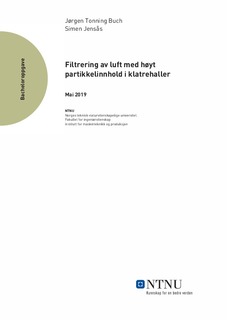| dc.contributor.advisor | Wenaas, Terje Arne | |
| dc.contributor.author | Buch, Jørgen Tonning | |
| dc.contributor.author | Jensås, Simen | |
| dc.date.accessioned | 2019-09-06T14:05:12Z | |
| dc.date.available | 2019-09-06T14:05:12Z | |
| dc.date.issued | 2019 | |
| dc.identifier.uri | http://hdl.handle.net/11250/2613413 | |
| dc.description.abstract | Bruken av klatrekalk gjør at klatrehaller skiller seg fra andre typer idrettsbygg, på grunn av et høyt partikkelinnhold i romluften. Det foreligger ingen klar veiledning for valg av filter og filterprinsipp i denne typen bygg. Partikkelinnholdet i inneluften fører med seg et behov for å filtrere avtrekksluften før den når komponenter i ventilasjonsaggregatet. Det er heller ingen forhåndsbestemt anbefaling for valg av varmegjenvinner.
Det er foretatt målinger og analyser av ventilasjonsaggregatet og inneklimaet ved én utvalgt klatrehall. Alle målinger er gjennomført både ved omlufts- og friskluftsinnstilling på ventilasjonsanlegget. Dagens filtermetode er undersøkt ved å finne filtereffektivitet, og konsentrasjonen av svevestøv som slippes inn igjen i klatrehallen. Det er foretatt målinger av partikkelinnhold, CO2, temperatur og relativ fuktighet i ventilasjonsaggregatet og i klatrehallen.
Avtrekket er plassert såpass langt unna forurensningskilden at det er oppdaget en treghet fra konsentrasjonen av svevestøv øker, til ventilasjonsanlegget klarer å kvitte seg med økningen. Selv om dagens to-trinns filtrering i avtrekkskanalen er god, legger det seg svevestøv i og rundt varmegjenvinneren. Spesifikt for denne klatrehallen er det målt et unormalt høyt CO2-nivå i tilluftskanal. Dette førte til en feilsøking, som resulterte i funn av kortslutning mellom inntaks- og avkastrist.
Oppgaven konkluderer med at en totrinns filtrering med et grov- og finfilter i avtrekket gjør jobben, men at det kan benyttes enda et filter i tilluft av hygieniske årsaker. En roterende varmegjenvinner er ikke å anbefale i denne typen bygg da roterende deler er utsatt for støv over tid. | |
| dc.description.abstract | The use of climbing chalk (magnesia alba) makes climbing facilities different from regular sport facilities, because of the large number of particles. There is no specific guidance for choices of filters in this type of buildings. The number of particles makes it necessary to filtrate the exhaust air before it reaches components in the ventilation unit. There is no predetermined recommendation for the choice of heat exchanger.
It is done experiments and analyzes of the ventilation unit and the indoor air quality at one specific climbing hall. All the experiments are done at recirculated air and fresh air on the ventilation unit. Today’s filter method has been examined by finding the efficiency of the filters, and the concentration of particles that is added to the building. Experiments have also been made on the number of particles, carbon dioxide, temperature and the humidity in the facility.
The extract is placed a bit away from the source of pollution, and it is therefore made a discovery that there is an inertia from when the concentration of particulate matter increases, until the ventilation unit can get rid of the increased amount. Even if today’s two-step filtration in the extract is good, there is climbing chalk in the heat exchanger. What is special for this climbing hall is the high amount of carbon dioxide in the supply air. This led to a troubleshooting, which resulted in a discovery of a short circuit between the intake and the draft.
This thesis concludes that a system with filtration of the exhaust air in two stages is sufficient to keep the inlet air clean enough. However, it can be used an additional filter before the supply air duct in regard to hygiene measures. The use of a rotary heat exchanger is not recommended in this kind of facility as rotating parts are exposed to dust over time. | |
| dc.language | nob | |
| dc.publisher | NTNU | |
| dc.title | Filtrering av luft med høyt partikkelinnhold i klatrehaller | |
| dc.type | Bachelor thesis | |
